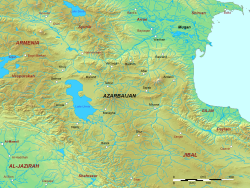Abu Mansur Wahsudan
| Abu Mansur Wahsudan | |
|---|---|
Amir | |
 The Imamzadeh Chaharmenar in Tabriz, where the Rawadid rulers are buried | |
| Ruler of Azarbaijan | |
| Reign | 1025 (?) – 1058/59 |
| Predecessor | Abu Nasr Husayn II (?) |
| Successor | Abu Nasr Mamlan II |
| Died | 1059 |
| Issue | Abu Nasr Mamlan II Abu'l-Hayja Manuchihr Abu'l-Qasim Ibrahim |
| Dynasty | Rawadids |
| Father | Abu'l-Hayja Mamlan I |
Abu Mansur Wahsudan (also spelled Vahsudan;
Background
Wahsudan was a son of the
Reign

In contrast to the other relatively obscure Rawadid amirs, Wahsudan's reign is better attested because of the preservation of the sixty panegyric qasidas (a form of poetry) composed by the Persian poet Qatran Tabrizi. Nevertheless, details of his early reign are almost unknown. At an unspecified date, Wahsudan sent a large force led by his son Abu Nasr Mamlan, who was accompanied by Qatran, against the Ispahbadh of Mughan. The latter was defeated and forced to acknowledge Rawadid authority. Abu Nasr Mamlan subsequently built a fortress in the town of Ardabil.[2][3]
It was during the reign of Wahsudan that Azarbaijan experienced incursions by migrating
In retaliation, Wahsudan and Abu'l-Hayja ibn Rabib al-Dawla defeated the Iraqiya, who were scattered into different groups which went to Ray, Isfahan and Hamadan. Regardless, the Iraqiya continued to pose a threat to the Rawadids, as Wahsudan invited them to a banquet where he massacred them and had forty of their leaders arrested in 1040/41. As a result, most of the Iraqiya subsequently withdrew to Hakkari. In 1041/42, another group of Iraqiya reached Azarbaijan from Ray, where they had fled from the Seljuk commander Ibrahim Inal. They engaged Wahsudan in a number of battles, including one near Sarab where they suffered a heavy defeat. The Wahsudan ultimately expelled them.[2][4]
The eviction of the Iraqiya from Azarbaijan gave Wahsudan the opportunity to improve his relations with the neighbouring
The circumstances of the transition of power between Wahsudan and his son Abu Nasr Mamlan are uncertain. According to Münejjim Bashi, Wahsudan died in 1059, but Ibn al-Athir reports that Abu Nasr Mamlan was recognised by Tughril as the ruler of Azarbaijan in 1058/59.[2] Wahsudan also had a third son named Abu'l-Qasim Ibrahim, but nothing is known about him.[2]
Culture
The Rawwadids were promoters of Persian culture demonstrated by Wahsudan and Mamlan II's patronage of Qatran.[2]
References
- ^ Bosworth 1996, p. 72.
- ^ a b c d e f g h i j k Peacock 2017.
- ^ Minorsky 1954, p. 524.
- ^ a b c d e Madelung 1975, p. 238.
- ^ Madelung 1975, p. 239.
Sources
- ISBN 978-90-04-09834-3.
- Bosworth, C.E. (1996). The New Islamic Dynasties: A Chronological and Genealogical Manual. New York City: ISBN 0-231-10714-5.
- Dehghan, I. (1978). "Ḳaṭrān". In OCLC 758278456.
- ISBN 0-521-20093-8.
- S2CID 159901706.
- Peacock, Andrew (2017). "Rawwadids". Encyclopædia Iranica, online edition. New York.
{{cite encyclopedia}}: CS1 maint: location missing publisher (link)
